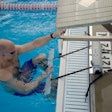Summertime brings with it long, sunny days and the chance for people of all ages and backgrounds to get outside and enjoy the weather. For athletic and recreational facility managers and other professionals, it’s when your facilities will likely see the most traffic—and it’s important to do everything possible to maintain the health and safety of your users.
One factor that’s increasingly important to consider in an era of changing climate: Excessive heat. On very hot days, the potential for heat-related illness increases for athletes participating in sports or other forms of exercise. There are ways for athletic and recreation managers to help mitigate some of the risk, like ensuring functional drinking fountains, access to shaded areas, and other strategies.
For outdoor playing surfaces like tennis or pickleball courts, there are also new technologies that can be applied to help beat the heat—all while providing a safer and more comfortable experience for your users. Here’s what to look for:
Solar Reflectivity: An Important Surface Coating Feature
Whether you’re resurfacing an existing court or building a new one, an increasingly important feature to consider when selecting a surface coating is its solar reflective index, or SRI. This metric measures the surface’s ability to reflect the sun’s rays, and thus its ability to help reduce the associated heat and the creation of heat sinks.
A heat sink is a phenomenon that is created in outdoor built environments, where the temperature becomes hotter than the natural surrounding environment. In order to combat them, reflective surfaces have become more popular in a range of applications—including industrial rooftops, parking lots, and others—and they can be applied to sports surfaces as well, helping to keep the temperature cooler and more comfortable.
Consider a tennis court, which can become significantly hotter than the ambient air temperature when the sun is shining, potentially reaching up to 140 F (60 C) on a hot day. The heated court surface further radiates heat back into the surrounding air, creating a hotter microclimate around the court. For athletes, such conditions can lead to…
· Faster dehydration
· Increased heart rates
· Greater fatigue
· Muscle fatigue and cramping
· Inhibited cognitive function
· Increased risk of heat-related illnesses
A surface that can reflect a certain amount of sunlight can add real value to your facility, helping to maintain more desirable on-court temperatures even at full sun exposure.

But reflective surfaces require balance. Too reflective a surface can shine UV rays back into the players eyes, negatively impacting visibility. For this reason, color coordination must be carefully considered. For example, pickleball remains one of the most rapidly growing sports in America, necessitating the construction of new courts that are often desired in custom color schemes versus that traditional dark greens and reds of tennis courts. Grays and blues are popular among these proliferating pickleball courts, and an experienced surface supplier should be able to assist you in achieving the right option when it comes to reflective surfaces.
Additional Ways to Enhance On-Court Play
For athletic professionals seeking to enhance their facilities, it’s worth exploring additional benefits that an optimal sports surface can deliver.
Some surface coatings, for example, incorporate acrylic resins and rubber granules that are designed to absorb impact and redistribute pressure, delivering enhanced shock absorption. This enables a more desirable feel for the athlete without compromising durability or the surface. The resulting effect can make a major difference for today’s top-line recreational facilities.
Shock-absorbing systems may not be suitable for all sports, but they can be worth strategic application. Pickleball provides another suitable use-case: A cushioned system can be advantageous, given the sport’s “anyone can play” accessibility, better accommodating players of any skill, fitness or age level.
As with solar reflection, balance is important here, too. Too soft a surface can impact the bounce of the ball, leading to adverse playing conditions. Excessive cushioning can contribute to the greater likelihood a player may experience an injury while playing such as a rolled ankle. An ideal system should see players not noticing much of a difference during gameplay--but it can help alleviate some of the next-day soreness that can occur after playing on a hard court.
***
Forward-thinking athletic facility and recreation managers have the opportunity to apply today’s advanced technologies in a broad range of applications to enhance their properties to best suit the needs of their users. Reflective and cushioned sports surfaces are just a few of the options that can help athletes at your facility be all that they can be.
Daniele Doerge is the Marketing Manager for California Sports Surfaces, a division of ICP Building Solutions Group. To learn more, visit www.CaliforniaSportsSurfaces.com or contact your representative.



































